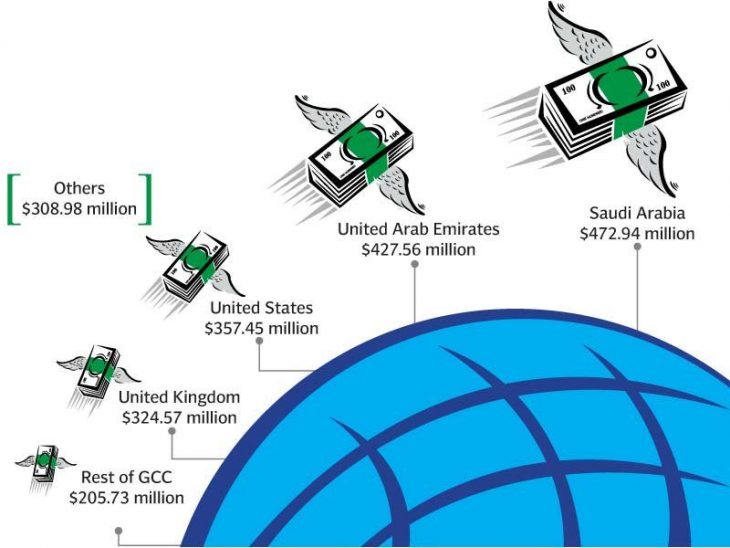
Remittances of Pakistan hit 7-month high at $2.09b in December 2019
KARACHI (The Express Tribune): Remittances of Pakistan touched a seven-month high at $2.09 billion in December 2019 apparently due to a sharp increase in the number of people who found jobs abroad last year.
The inflow of workers’ remittances was 15% higher compared to the prior month of November 2019 and 20% higher compared to December 2018, the State Bank of Pakistan (SBP) reported on Saturday.
Some 625,203 Pakistanis went aboard in 2019 compared to a total of 382,439 in 2018, the BE&OE reported on its official website. The total number of Pakistanis working across the country’s borders increased around 6% in 2019 to 11.11 million.
A banker, who heads the remittances department at a large bank, pointed out that a significant increase in Pakistanis taking up jobs in different companies abroad may have played a big role in boosting remittances of Pakistan.
On average, over 1,700 Pakistanis found jobs in foreign countries every day in the year ended December 31, 2019 compared to over 1,000 people per day in 2018, according to a statement issued by the Bureau of Emigration and Overseas Employment (BE&OE).
Visits of Prime Minister Imran Khan to member countries of the Gulf Cooperation Council (GCC) also brought positive results as he urged the leadership of the GCC states to facilitate the Pakistani workforce.
“Present government improved diplomatic relations with Gulf states, which helped restore the confidence of foreign employers in the Pakistani workforce,” the BE&OE said in its mid-year (Jan-Jun 2019) analysis of manpower export.
The notable growth in Remittances of Pakistan in December 2019 helped improve the overall remittances by 3% to $11.39 billion in first half (Jul-Dec) of current fiscal year 2019-20 compared to $11.03 billion in the same period of previous fiscal year, the SBP said.
“The diplomatic efforts coupled with oil price stability created more employment opportunities for Pakistani workforce mainly in Saudi Arabia and the UAE – the largest destinations for Pakistani expatriate workers,” the comprehensive report said.
“The increase in December remittances is seasonal,” remarked Taurus Securities Deputy Head of Research Mustafa Mustansir.
He elaborated that the Pakistani workers abroad sent home higher amounts during winter holidays, which fall in December every year.
Many countries enjoy higher sales of consumer goods during the holiday season, especially during Christmas holidays. “This encourages the employers abroad to pay bonus in these months,” he said.
BE&OE numbers suggested that a majority of the Pakistanis found jobs in foreign countries as labourers followed by drivers. “The (seasonal) factor may continue to keep Remittances of Pakistan at high levels in January as well,” the analyst said.
Secondly, the international crude oil prices have remained high in the ongoing fiscal year. “This has possibly boosted incomes of workers in the oil-exporting Middle Eastern nations where majority of the Pakistanis are employed,” he said.
The analyst added that his brokerage house had estimated an overall 3% improvement in remittances to around $22.5 billion in the full fiscal year 2019-20 compared to $21.83 billion in FY19.
SBP Governor Reza Baqir, however, said on Friday that overseas Pakistanis were increasingly using informal channels for sending remittances to the country. “We are seeing that the use of formal channels for sending money [by the expatriates] is not growing as much as the use of informal channels,” he said.
Reasons for this may be comparatively higher cost of sending money through formal channels and the many questions asked by banks from the remittance senders, he added. Bankers and experts have estimated that the receipt of remittances through the illegal channels stood at around $8 billion a year.
A few months ago, the government launched a crackdown on operators of the illegal Hundi and Hawala money transfer system, ran a campaign to encourage the use of legal channels like banks and announced incentives for those utilising legal channels to remit money.
The crackdown helped increase remittances from different countries including the US and the UK, an analyst said the other day.
Country-wise Remittances Received by Pakistan
In December 2019, the inflow of workers’ remittances from Saudi Arabia amounted to $472.94 million compared with the inflow of $414.59 million in December 2018.
Workers from the UAE sent home $427.56 million in December compared to $351.19 million in the same month of last year. They sent $357.45 million from the US compared to $276.29 million last year whereas from the UK remittances stood at $324.57 million compared to $267.79 million.
Pakistanis remitted $205.73 million from GCC countries (including Bahrain, Kuwait, Qatar and Oman) compared to $174.42 million in December 2018. They sent $56.42 million from EU countries compared to $47.48 million. Remittances received from Malaysia, Norway, Switzerland, Australia, Canada, Japan and other countries during December 2019 amounted to $252.56 million against $216.35 million in December 2018, the central bank reported.
